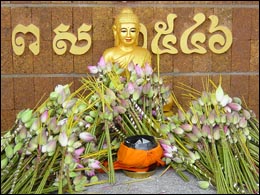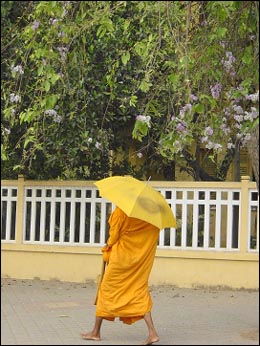 RELIGION RELIGION |
India's main contribution to the Southeast
Asia, apart from his language, Sanskrit,
is its religion, which were both predominant
means of expression. The first historical
evidence for the spread of religions originating
in India to Southeast Asia can be found
in the form of inscriptions and bronze images
of the Buddha. Discovered all along the
trade routes, most of these works reflect
Indian or Singhalese styles but do not date
further back than the 5th of 6th century.
Nevertheless the fact that this early images
were Buddhists does not mean that Buddhism
was the first religion in Southeast Asia.
It is believed that animist believes were
common before Buddhism was adopted at the
same time as Brahmanism (or Hinduism). Even
if Siddhartha Gautama's concepts, in the
6th century, were in direct contrast to
the Hindu believes in an eternal, blissful
Self, or Paramatman, and hence Buddhism
was originally a heresy against India's
Brahmanic religion, they both have developed
side by side since then. As it is the case
in India, these two religions seem to have
focused more on their common points rather
than on their differences. One of the notable
aspects of the Indian religion in Cambodia
lies in their harmonious coexistence, sometimes
verging on syncretism, which is reflected
again and again in both inscriptions and
monuments. Furthermore these strict faiths
did not result in any king of paralysis
and once they had taken roots they evolve
to produce fruits unknown in their mother
country, India. These have been mainly remarkable
in the Khmer Art.

Nowadays more than 95% of the Cambodians
are Theravada Buddhist; nevertheless other
regions remain such as Islam, Christianity,
Animism and Caodaism. In this section we
do not intent to represent all the religion,
in fact we will just introduced the Buddhism
as well as Caodism, which is less known
than the other traditional religions.
 BUDDHISM BUDDHISM |
Buddhism as Christianity and Islam is based
on the teachings of an historical figure;
Siddhartha Gautama; known as Buddha, or
the enlightened one. Siddhartha Gautama
was born prince in the northern India in
the 6th century BC. He turned ascetic and
spent much of his life contemplating the
meaning of existence, which he connected
with suffering. He subjected himself to
many years of austerity to reach the "enlightenment".
Even if this latter never claimed to be
divine, his teachings have been since then
transmitted by Buddhist monks. The essence
of this philosophy lied in the fact that
with proper behaviour and thinking, gathered
in four noble truths (Existence is suffering/
Suffering is caused by desire/ Conquer desire
and suffering will disappear/ Follow the
eight-fold path in order to conquer desire),
individuals were able to overcome suffering
and reach enlightenment.
Buddhism is now divided into two main currents;
the Theravada school, also called "southern"
school as it took the southern route from
India, its place of origin, through Southeast
Asia: Myanmar, Thailand, Laos and Cambodia;
and the "northern" school, which
proceed north into Nepal, Tibet, China,
Korea, Mongolia, Vietnam and Japan. The
southern school limited the Buddhist doctrines
to the ones codified in the early Buddhist
era and the northern school designated it
as Hinayana, which means the "lesser
vehicle". Theravada doctrine stresses
the three principal aspects of existence:
Tukha (suffering, unsatisfactory, disease),
Anicha (impermanency, transience of all
things) and Annatto (no substantiality or
no essentiality of reality: no permanent
soul).
The northern school considered itself the
"greater vehicle" as, even if
founded in the same early doctrines, it
claim to have expended them through the
years in order to meet and respond better
to the needs of people.
 MODERN
BUDDHISM IN CAMBODIA MODERN
BUDDHISM IN CAMBODIA |
Buddhism widely spread in Cambodia since
the King Jayavarman II, father of the Angkor
Kingdom, embraced the so-called Great Vehicle
brand of Buddhism (Mahayana). Later on,
influenced by Siam and Burma missionaries,
most Cambodian practiced Hinayana, or "Lesser
Vehicle" Buddhism, which was more austere
than Mahayana.
|

The earliest Buddhist statues found in
the ruins of ancient Cambodian temples date
from the 2nd century. Many of the splendid
stone Buddha's on view today in the National
Museum in Phnom Penh were taken from the
ruins of 5th century temples. Around the
country there are 3,371 pagodas, including
some 90 in Phnom Penh. Buddhism suffuses
the life of most Cambodians with spiritual
meaning and hope. In Modern Cambodia, the
Buddhism cult is centred on religious happenings
hold at the Wat (monasteries) through the
year.
 CAODAISM CAODAISM |
Dao Cao Dai (Caodaism in English) is the
third largest religion in Viet Nam. "Cao"
means "high"; "Dai"
means "palace". Caodai refers
to the supreme palace where God reigns.
This word is also used as God's symbolic
name.
Caodaism is a syncretistic religion, which
combines elements from many of the world's
main religions, including Buddhism, Confucianism,
Christianity, Hinduism, Islam, Judaism,
Taoism, as well as Genism, an indigenous
religion of Viet Nam.
Caodaism regards the history of religion
as being divided into three periods of revelation.
The first was circa 2500 BCE, when God inspired
selected religious leaders to found Judaism
in the Middle East, Hinduism in India and
Yi king (philosophy of transformation) in
China. A few thousand years later, God led
the Buddha to found Buddhism, Lao Tse to
create Taoism, Confucius to start Confucianism,
and Jesus Christ to found Christianity.
Caodaism affirms that, due to the frailty
of those religious leaders, the truth became
distorted. A number of religions were formed,
but most flourished only in or near their
countries of origin. Religions became adapted
to the needs of individual cultures. Limitations
in communication and transportation prevented
the formation of a single, true universal
religion which all of humanity could embrace.
Followers of Caodaism believe that God was
concerned that the multiplicity of religions
prevented people from living together in
harmony. God decided to initiate a third
revelation, in which he communicated Caodaism
by spiritualist means.
Ngo Van Chieu, a civil servant of the Cochin
China government began to receive messages
from a spirit called Duc Cao Dai, whom he
believed to be God. After three years of
studying and worshipping God, he shared
his spiritual discoveries with others in
Saigon (actual Ho Chi Min City). At the
end of the year At Suu (1926 CE), Cao Dai
instructed a small group of mediums to found
a new religion. One of the mediums, Le Van
Trung was named by God to be acting Giao
Tong (Pope).
Caodaism was formally founded on 1926 by
a group of 247 disciples. Spiritualism is
the method that God chose to transmit this
new religion to humanity. A mechanical device
is commonly used as a means of communication
between spirit beings and humans.
With the unification of Viet Nam in 1975,
the Communist government restricted the
Caodaists' activities. Their Cuu Trung Dai
(executive body) and Hiep Thien Dai (legislative
body) were been abolished and replaced with
a Governing Council under the direct control
of the government. Rituals and ceremonies
continued without government interference.
A new order dawned in mid-1997, when the
religion received official sanction from
the government.
Cadaism defends the existence of a single
god for all human and gathering all religions.
They have also the concept of a Karma that
will remain after death and will lead to
a better or worth reincarnation. It is believed
that if you have a bad Karma you could be
reincarnated in an other planet, much cooler
and darker than earth. If the Karma is good
than the reincarnation will be to a better
position on earth or even reach the Heaven
or Nirvana.
To know more about Caodism;
The Sydney Centre for Studies in Caodaism
maintains a home page at:
http://www-personal.usyd.edu.au/~cdao/tam.htm
|

